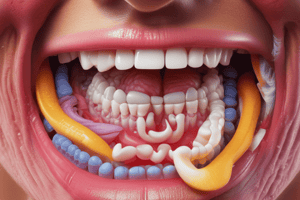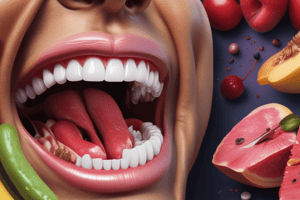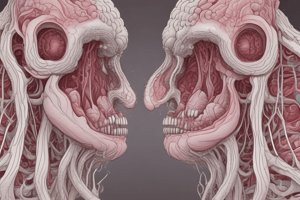Podcast
Questions and Answers
What type of epithelium is found in the loosely attached mucosa?
What type of epithelium is found in the loosely attached mucosa?
- Cuboidal epithelium
- Keratinized stratified squamous epithelium
- Columnar epithelium
- Non-keratinized stratified squamous epithelium (correct)
Which of the following is a characteristic of the firmly attached mucosa?
Which of the following is a characteristic of the firmly attached mucosa?
- Thin keratinized stratified squamous epithelium (correct)
- Columnar epithelium with many epithelial ridges
- Cuboidal epithelium with few or no epithelial ridges
- Thick non-keratinized stratified squamous epithelium
What is the function of the vestibular fornix?
What is the function of the vestibular fornix?
- To produce saliva
- To produce mucus
- To allow mobility of the tongue
- To allow mobility of the lips and cheeks (correct)
Which papilla is associated with von Ebner salivary glands?
Which papilla is associated with von Ebner salivary glands?
What type of fibers are found in the lamina propria of the loosely attached mucosa?
What type of fibers are found in the lamina propria of the loosely attached mucosa?
Which of the following is NOT a characteristic of the floor of the mouth?
Which of the following is NOT a characteristic of the floor of the mouth?
What is the function of the Weber salivary glands?
What is the function of the Weber salivary glands?
What is the term for the junction between the alveolar mucosa and the gingiva?
What is the term for the junction between the alveolar mucosa and the gingiva?
What type of collagen is present in anchoring fibers?
What type of collagen is present in anchoring fibers?
What is the function of hemidesmosomes in epithelial cells?
What is the function of hemidesmosomes in epithelial cells?
What is the characteristic of the epithelium in the hard palate?
What is the characteristic of the epithelium in the hard palate?
What is the term for the area between the gingiva and the alveolar mucosa?
What is the term for the area between the gingiva and the alveolar mucosa?
What is the function of the gingival fibers?
What is the function of the gingival fibers?
What is the characteristic of non-keratinized mucosa?
What is the characteristic of non-keratinized mucosa?
What is the term for the epithelial projections in the hard palate?
What is the term for the epithelial projections in the hard palate?
What is the function of the soft palate?
What is the function of the soft palate?
What type of epithelium is present on the nasal side of the soft palate?
What type of epithelium is present on the nasal side of the soft palate?
What is the term for the area on the lip that separates the skin from the mucous membrane?
What is the term for the area on the lip that separates the skin from the mucous membrane?
What is the primary function of the oral mucous membrane?
What is the primary function of the oral mucous membrane?
Which layer of the oral mucosa is composed of connective tissue?
Which layer of the oral mucosa is composed of connective tissue?
What is the name of the layer of connective tissue that extends into the deep surface of the epithelium?
What is the name of the layer of connective tissue that extends into the deep surface of the epithelium?
Which of the following is NOT a function of the oral mucous membrane?
Which of the following is NOT a function of the oral mucous membrane?
What is the name of the sensation that is sensed in the mouth through certain receptors?
What is the name of the sensation that is sensed in the mouth through certain receptors?
Which part of the oral cavity is lined by the oral mucosa?
Which part of the oral cavity is lined by the oral mucosa?
What is the name of the layer of the oral mucosa that is thicker in areas of masticatory mucosa?
What is the name of the layer of the oral mucosa that is thicker in areas of masticatory mucosa?
What is the name of the part of the oral cavity that is located between the teeth and the lips?
What is the name of the part of the oral cavity that is located between the teeth and the lips?
Flashcards are hidden until you start studying
Study Notes
Oral Mucosa
- The oral mucosa is composed of two major components: oral epithelium and lamina propria.
- Functions of the oral mucosa include protection, sensation, secretion, and thermal regulation.
Types of Oral Mucosa
- There are three types of oral mucosa: keratinized mucosa (masticatory mucosa), non-keratinized mucosa (lining mucosa), and specialized mucosa.
Keratinized Mucosa (Masticatory Mucosa)
- Found in areas subjected to forces and pressure during mastication, such as the gingiva and hard palate.
- Characterized by stratified squamous keratinized epithelium, tall epithelial rete pegs, and dense lamina propria with numerous collagen fibers.
Non-Keratinized Mucosa (Lining Mucosa)
- Found in areas not subjected to high levels of friction but is mobile and distensible, such as the soft palate, lip, cheek, ventral surface of the tongue, floor of the mouth, and vestibule.
- Characterized by non-keratinized epithelium firmly attached to underlying muscles, with loosely attached mucosa to underlying structures.
Specialized Mucosa
- Found on the dorsal surface of the tongue, with four types of papillae: fungiform, foliate, circumvallate, and filiform.
- Each type of papilla has a specific function, such as taste sensation and mechanical protection.
Gingiva
- Macro-anatomy includes the free gingiva, interdental papilla, attached gingiva, and mucogingival junction.
- Histology includes stratified squamous keratinized epithelium, tall epithelial rete pegs, and dense lamina propria with numerous collagen fibers.
Palate
- Macro-anatomy includes the incisive papilla, palatine gingiva, rugae area, antero-lateral area, postero-lateral area, and median palatine raphe.
- Histology includes epithelial rete pegs, tall and numerous, with a mucosa consisting of a fatty zone and glandular zone.
Lip and Cheek
- Characterized by non-keratinized epithelium firmly attached to underlying muscles, with loosely attached mucosa to underlying structures.
- Histology includes a mucosa with a mixed salivary gland and a non-keratinized epithelium.
Tongue
- Dorsal surface contains four types of papillae: fungiform, foliate, circumvallate, and filiform, each with a specific function.
- Histology includes a mucosa with a stratified squamous epithelium and a lamina propria with numerous collagen fibers.
Lamina Propria
- Divided into the papillary layer and reticular layer.
- In areas of masticatory mucosa, the papillary layer is prominent, while in areas of lining mucosa, the reticular layer predominates.
Studying That Suits You
Use AI to generate personalized quizzes and flashcards to suit your learning preferences.




